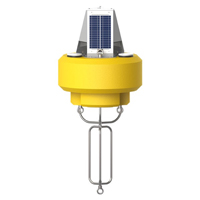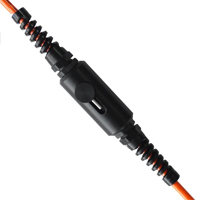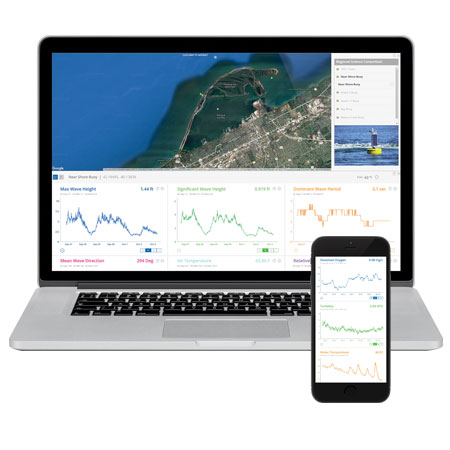Temperature and water chemistry are closely connected. When the chemical properties and water temperature within any body of water reach certain thresholds, a surprising number of phenomena can occur. Many of these are natural, and take place even without anthropogenic influence. Some changes aren’t negative by definition, and some may be unavoidable.
A real-time system for temperature profiling with thermistor strings equips decision makers with the best possible evidence as quickly as possible. This, in turn, allows for quick yet thorough, evidence-based judgments when signs of trouble crop up in a system.
In this post, we’ll touch upon temperature profiling in water more generally, and then describe an ideal temperature profiling system with thermistor strings. We’ll also explore why the ability to profile temperature in real-time is so important.
Potential Problems Temperature Profiling Reveals
There is more than one problem related to water temperature that people commonly monitor for, including thermal pollution, eutrophication, and stratification. The kinds of issues you’re monitoring will determine what your ideal temperature profiling solution looks like.
Thermal pollution, typically caused by the addition of too much industrial or municipal waste effluent, simply means an artificially high temperature in a river, stream, or lake. Rainwater runoff that carries toxic chemicals such as motor oil can also contribute to thermal pollution. Notably, sources of thermal pollution in, for example, a larger body of water like a lake have a cumulative impact.
Eutrophication, although primarily a result of high nutrient levels in water, is also encouraged by warmer temperatures. High temperatures also speed up other processes that contribute to eutrophication. The ultimate result is hypoxic “dead zones” in water that are difficult to remediate, so real-time monitoring of possible eutrophication-friendly conditions is essential.
Lake stratification happens during spells of warm weather when the sun heats the upper levels of a lake making that warmer water less dense. Water at the bottom of the lake stays cold and dense, and there is less mixing between the layers of water. This, in turn, means less available oxygen in the lower strata of the lake, threatening the species that live there. Stratification makes eutrophication more likely, and so these problems feed off one another.
Temperature Profiling: The Basics
Thermistors, resistors that react predictably and precisely when they encounter changing temperatures, are an ideal tool for temperature profiling. As the temperature rises around a Negative Temperature Coefficient (NTC) thermistor, it shows a drop in resistance. A Positive Temperature Coefficient (PTC) thermistor works in the opposite way, increasing electrical flow and resistance with temperature.
NTC thermistors are most frequently used for temperature profiling. Because they are designed to function within a specific range of temperatures, it may be necessary to calibrate this kind of thermistor between applications should operating conditions vary significantly.
To profile a lake’s temperature, it’s best to use multiple temperature nodes strung together and suspended from a buoy. Each node features an integral titanium thermistor secured and epoxied in a protective housing for underwater deployments. This allows you to take temperature readings at established intervals based on the conditions of the lake itself and ensure that the placement of the thermistors stays fairly constant.
Deciding where to locate your temperature profiling monitoring system is a complex process. First in mind should be the lake’s site conditions. It’s essential to plan carefully because before you deploy your system you must know the fluctuations in water level, depth, and weather conditions for your target location. Only then can you design an effective mooring solution that will keep your instruments safe.
For the best, most accurate reflection of the lake’s temperature profile, it’s best to monitor in the deepest part of the water, moored with a stainless steel line, anchor, and bottom chain. In calm waters, single-point mooring may be sufficient, but two-point mooring is usually ideal.
Thermistor strings can be complemented with other sensors, especially when deployed on a data buoy. An optimal thermistor string-buoy configuration usually includes the thermistor string itself, a built-in, solar-charged battery, a submersible data logger, and a cellular, radio, or Iridium satellite-based telemetry package for real-time monitoring with a smartphone, tablet, or computer from a remote location.
Real-time Temperature Profiling with Thermistor Strings
A lake’s width, depth, and other hydrological properties determine the ideal system for monitoring temperature stratification. However, other considerations such as man-made dams can also impact the temperature profiling process in a lake.
In every case, however, measurement data is more effective when collected and provided in real-time. A buoy-based temperature profiling system with thermistor strings is the most efficient and easiest way to do this.
This kind of system allows you to measure temperatures throughout the water column at multiple depths—and you determine what those depths will be, based on your needs and the lake’s requirements. Buoy-based temperature profiling systems are scalable, allowing you to deploy a single buoy if the lake is small, or as many buoys as needed in larger bodies of water. Once deployed, you can let the buoys do the work and transmit the data in real-time so you can see it wherever you are on your smartphone, tablet, or computer.
The right data buoy can accommodate as many sensors as your project demands. A recharging solar panel system and a marine battery power all of the equipment, and there are multiple choices when it comes to telemetry, so you never lose your stream of real-time data.
Better Data, Quicker Response
Problems like harmful algal blooms and contamination events develop rapidly. The only way to be ready for them is to keep watching for signs that something has gone wrong. Monitoring for unusual temperature conditions in real-time is a critical part of this effort.
To ensure your team is able to respond to unusual temperatures as soon as they occur, make sure you’re getting the data. A customized temperature profiling system with a thermistor string on a data buoy that has been designed for your lake or river is the smartest, state-of-the-art way to do that. For more on temperature profiling and equipment, see our guide here, or contact an expert.
Equipment
The NexSens CB-450 Data Buoy is designed for deployment in lakes, rivers, coastal waters, harbors, estuaries and other freshwater or marine environments.
The NexSens TS210 Thermistor String provides high precision temperature measurements for profiling in lakes, streams, and coastal waters.
WQData LIVE is a web-based project management service that allows users 24/7 instant access to data collected from remote telemetry systems.





0 comments